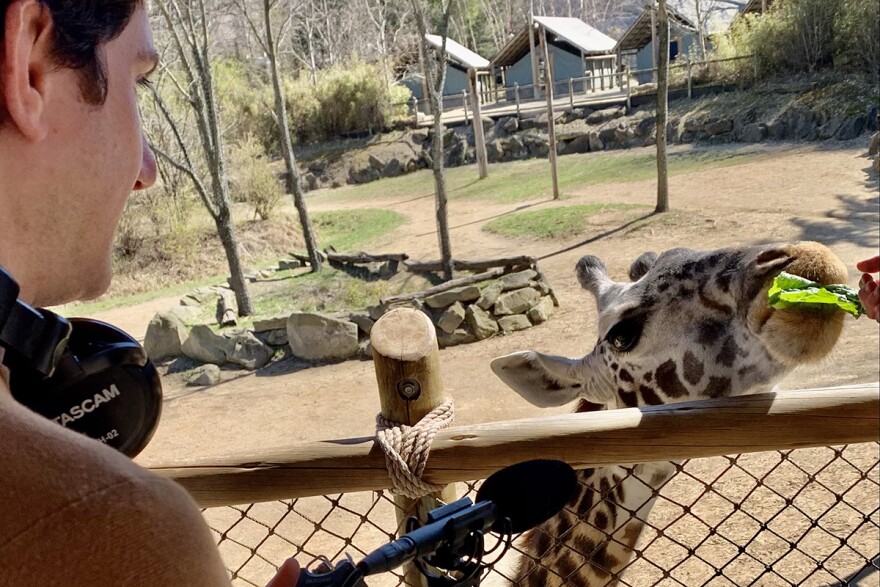“So if you were a giraffe or an elephant you would go along in your world and you would consume things off of trees. And so we try to mimic, as best we can, what we call browse, which is edible tree material.”
This week on the show, Toby Foster talks with Barbara Henry at the Cincinnati Zoo. She’s the one who figures out what each of the animals need to eat, where to source their food and the best ways to feed the animals to ensure that they thrive.
And, Harvest Public Media shares a story about recent USDA layoffs and the importance of plant libraries called herbaria.

A few years ago, I started following the Cincinnati Zoo and Botanical Garden on Instagram. Like some of you, I was drawn in by the story of Fiona the hippopotamus. She was born prematurely, too small to stand and nurse from her mom, Bibi, and had to be cared for around the clock for months to get the chance to grow into the healthy hippo she is today.
The zoo shared her story in real time on social media, and since then I have noticed that they share lots of photos of animals doing all types of things, but very often they are eating. I got the chance to visit the zoo recently to talk to Barbara Henry, the zoo’s curator of nutrition, and Angela Hatke, the zoo’s publicity manager.
Barbara played a big part in Fiona’s success story back in 2017. There are only 21 facilities in the country that are accredited by the Association of Zoos and Aquariums and have a full-time nutritionist on staff, and Barbara, along with the help of some colleagues at the Smithsonian’s National Zoo, was able to use her training to create a sort of hippo baby formula, which had to be constantly adjusted to mimic the milk that Fiona would have gotten from her mother.
The zoo has plenty of other residents as well, from Rico the porcupine and Hudo the Komodo dragon to penguins, snakes, and a wide variety of insects. Barbara must come up with a diet for them all. Then she has to figure out where to source all that food, as it all must meet the same standards that food for humans would in terms of quality. This is not always easy, as was evidenced during the pandemic when it became difficult to find beef blood, which is the only thing the vampire bats eat. “If you don’t have blood,” Barbara told me, “We can’t feed them. So you have to have a plan, and then a backup plan, and then another backup plan.”
Barbara is also the president of the Zoo and Wildlife Nutrition Foundation, whose mission is to provide nutrition education and advice and to contribute to global and regional nutrition research programs. Research and collaboration with other veterinarians and nutritionists is something that is very important to Barbara, and integral to her approach to nutrition.
Overall, Barbara says, “The diet can be used in so many different ways.” In addition to being nutritious, diet can encourage a certain behavior in an animal, such as foraging or exploring its habitat. It can also be used to mimic the natural cycle of an animal that usually hibernates during certain seasons. The diet can also be used as enrichment, training, or as a special treat, and these are often the moments that Angela shares with the zoo’s social media followers. In that way, too, food is used to connect with the public in a fun way that can also be educational and help share the zoo’s mission as a non-profit.
As someone who has been a vegetarian for over a decade, I realize that not everyone likes zoos. The concept of keeping an animal in a cage is not one that I necessarily love myself, and there are certainly many for-profit “zoos” which lack the means to, or maybe even intention of, taking care of their animals. I also believe, that a reputable, accredited zoo, such as the Cincinnati Zoo, places an emphasis on conservation and education, as well as the welfare of their animals, and it is zoos like that that gave me such a love for animals at an early age. Visiting Barbara and Angela at work reaffirmed my belief in this, as they are both clearly passionate about taking the best possible care of the zoo’s residents, and I thank them for that and for spending time with me.
And I got to feed a giraffe, which was pretty exciting!
Music on this Episode:
The Earth Eats theme music is composed by Erin Tobey and performed by Erin and Matt Tobey.
Additional music on this episode from Peter Woods and Universal Production Music.
Credits:
The Earth Eats’ team includes: Eoban Binder, Alexis Carvajal, Alex Chambers, Toby Foster, LuAnn Johnson, Leo Paes, Daniella Richardson, Samantha Shemenaur, Payton Whaley and Harvest Public Media.
Earth Eats is produced, engineered and edited by Kayte Young. Our executive producer is Eric Bolstridge.


